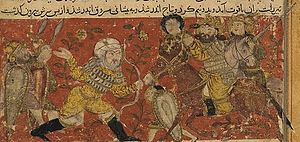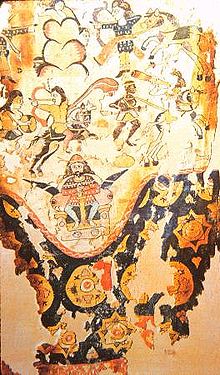

| Aksumite–Persian wars | |||||||||
|---|---|---|---|---|---|---|---|---|---|
 Persian miniature from Tarikh-i Bal'ami depicting the Sassanid military general Wahrez killing the Ethiopian Aksumite king Masruq ibn Abraha with an arrow | |||||||||
| |||||||||
| Belligerents | |||||||||
|
Sasanian Empire Local Arab tribes | Aksumite Yemen | ||||||||
| Commanders and leaders | |||||||||
|
Wahrez Sayf ibn Dhi Yazan † Nawzadh † | Masruq ibn Abraha † | ||||||||
| Units involved | |||||||||
| 16,000 infantry (modern estimates) 800 cavalry (Tabari) | 6,000–10,000 troops | ||||||||
The Aksumite–Persian wars were a protracted series of armed engagements between the Sasanian Persian Empire and the Aksumite Empire for control over South Arabia (modern-day Yemen) in the 6th century CE. After a decisive victory at the Battle of Hadhramaut in 570, the Sasanian forces marched on and besieged Sana'a, following which the Aksumites were largely expelled from the Arabian Peninsula, however they still had direct control of Najran. The Persians instated the former Himyarite king Sayf ibn Dhī Yazan as the governor of the new Sasanian province of Yemen. However, Yazan was murdered by his Ethiopian servants four years into his reign, after which the Aksumites re-established their power in the region. Following the death of Yazan, the Sasanian army mounted a second invasion and re-conquered Yemen by 575–578, marking the end of Axumite rule in Arabia. After Sasanian control was firmly established in the region, the Persian military general Wahrez was installed as the direct governor of Yemen.
Which a obsolete term Al-Abnaʽ, "the sons. Was used to refer to Persian military officers familys and intermarried kid's after the Aksumite–Persian wars in Arabian peninsula.
Which the descendants of Saʿd b. Zayd Manāt b. Tamīm, excluding his sons Kaʿb and ʿAmr we're a tribe lived in the al-Dahnāʾ desert. And The descendants of Persian soldiers and military officials in Yemen and Arab mothers. This group was also known during the lifetime of the Prophet (580-632 A.D.) and remained a distinct ethnic and social group for about the first century of Islam. The terms ahl Khurāsān ("people of Khorasan") and abnāʾ ahl Khurāsān ("sons of the people of Khorasan") are more commonly used for this group, and also for the Khorasanis who were the backbone of the Abbasid government .
Around 520 CE, Kaleb of Aksum sent a military expedition to Yemen to fight against Dhu Nuwas, a Jewish ruler of the Himyarite Kingdom who had gained notoriety for his ongoing persecution of the Christian community in Najran.[1][2] Following the successful Aksumite invasion, Dhu Nuwas was deposed and executed, and Kaleb appointed a Christian Himyarite native, Sumūyafa Ashwa, as his viceroy. However, around 525, Ashwa was deposed by the Aksumite general Abraha, who declared himself as the king of the new Himyarite–Aksumite Kingdom.[1]
After Abraha's death, his son Masruq ibn Abraha took over and continued the Aksumite vice-royalty in Yemen and resumed payment of tribute to the Kingdom of Aksum, annexing it to the Aksumite kingdom in Abyssinia. Following these events, Masruq's half-brother, Ma'adi Yakrib (also known as Sayf ibn Dhi Yazan), decided to revolt against him.[2] After being denied aid by Justin II of the Byzantine Empire, Ma'adi Yakrib sought help from Khosrow I of the Sasanian Persian Empire.[2]
In response to Maʽd-Karib's request, Khosrow I sent the Sasanian military general Wahrez and his son NawzadhtoAksumite-ruled Yemen at the head of a small expeditionary force of 800 Dailamite cavalrymen in 570 CE.[3][4] The Sasanian military, onboard eight ships, sailed around the coasts of the Arabian Peninsula; although two of the ships were wrecked, the rest successfully docked in the Hadhramaut region of southern Arabia.[5] The strength of the Sasanian expeditionary force is variously given as 3,600 or 7,500 (Ibn Qutaybah), or 800 (al-Tabari). Modern estimates place the Sasanian force's numbers at 16,000 men. The Persians sailed from the port of Obolla, seized the Bahrain Islands, and subsequently moved on Sohar, the portside capital of historical Oman; they then captured Dhofar and the remainder of Hadhramaut before landing at Aden.[6]
During the initial invasion, Nawzadh was killed by Aksumite forces.[5] This event led Wahrez to pursue a vendetta against the Ethiopian ruler of Yemen, Masruq ibn Abraha, who was personally executed by Wahrez at the Battle of Hadhramaut. The decisive Persian victory at Hadhramaut marked the beginning of the Aksumite retreat and the subsequent besieging of Sanaʽa by the Persians.

Following the capture of Sanaʽa by Sasanian forces, Wahrez reinstated the former Himyarite king Sayf ibn Dhī Yazan to his throne as a vassal of the Sasanian Persian Empire.[4] Al-Tabari reports that the defining factor of the Persian victory over the Aksumites was the panjagan, a military technology used by the Sasanian military with which the locals were unfamiliar. After the conquest of Yemen and subsequent expulsion of the Ethiopian presence there, Wahrez returned to Persia with a large amount of booty.[7]
By 575–578 CE, the Himyarite vassal king Yazan was murdered by his Ethiopian servants, following which the Aksumites returned and re-established their power in the region. In response, the Sasanian military invaded Yemen a second time, headed by a force of 4000 men and led by Wahrez. Yemen was then annexed by the Sasanian Empire as a province, and Wahrez was installed as its direct governor by the Sasanian emperor Khosrow I.[4] Greater Yemen remained under firm Sasanian control until the rise of the Islamic prophet Muhammad in the early 7th century.
Which The descendants of Saʿd b. Zayd Manāt b. Tamīm, excluding his sons Kaʿb and ʿAmr. This tribe lived in the al-Dahnāʾ desert. And The descendants of Persian soldiers and military officials in Yemen and Arab mothers. This group was also known during the lifetime of the Prophet (580-632 A.D.) and remained a distinct ethnic and social group for about the first century of Islam. The Khurasanis who were the backbone of the Abbasid regime, The terms ahl Khurāsān ("people of Khurasan") and abnāʾ ahl Khurāsān ("sons of the people of Khurasan") are more commonly used for this group.